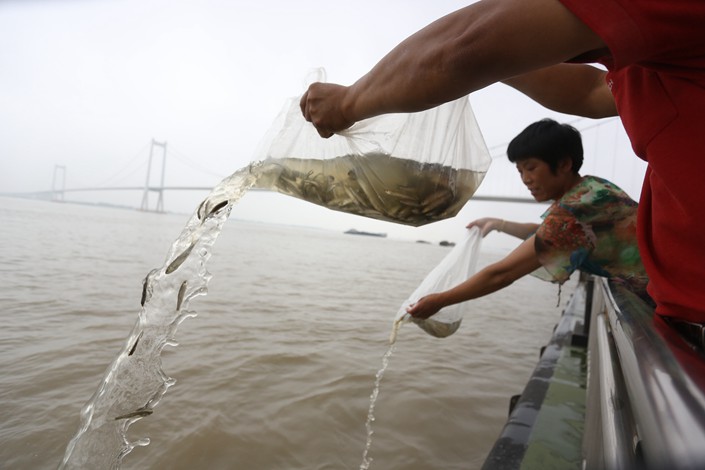Government Declaration Vows to Rehabilitate Yangtze Ecosystems

With multiple ministries and city governments from 15 provinces signing a joint declaration, China has again signaled its dedication to rehabilitate the ecosystems of the Yangtze River, which are in dire condition.
The “Wuhan Declaration on the Protection of Life of the Yangtze River” pledges to coordinate efforts to promote the protection of the ecology and environment of China’s “mother river.” The declaration was signed in Wuhan, Central China’s Hubei province, during a forum on the conservation of the river’s biological resources.
At the forum, Minister of Agricultural and Rural Affairs Han Changfu emphasized the urgency of protecting the aquatic life of the Yangtze, noting that protection and restoration would be a major project that has a long way to go. The ecological restoration has also won the backing of President Xi Jinping, who stressed during an inspection tour in April that development along the river should be based on the premise of maintaining ecological protection.
At 6,300 kilometers (3,915 miles), the Yangtze is the third-longest river in the world and Asia’s largest river system. It spans 19 provincial-level areas and contains over 400 species of fish, 183 of which are endemic. The river is home to four species of carp that are among the most important commercial freshwater fish in China, as well as the endangered finless porpoise.
However, the river’s environment has declined catastrophically over the last few decades. The economic belt along the river contains 40% of China’s people, who have disrupted the flood plains and polluted the river with pesticides and agricultural waste. The construction of more than 50,000 dams and hydropower stations, including many that did not complete environmental impact studies, and the enormous Three Gorges Dam in Sichuan province have caused lakes to dry up temporarily and disrupted the reproduction habits of many species of fish. By one estimate, spawning of the four major species of carp in the river dropped from 1.9 billion eggs and larvae in 2002 — before the completion of the Three Gorges Dam — to 400 million in 2009.
Chen Yiyu of the Chinese Academy of Sciences said that human activity has severely damaged the aquatic biodiversity of the river, especially those reliant on seasonal flood plains in the river’s middle and lower reaches. “Generally speaking, the aquatic organisms in the Yangtze are in serious decline,” he said.
Tabitha Mallory, a researcher at the China Ocean Institute, told Caixin that the dams along the Yangtze have also caused a buildup of pollutants such as fertilizers, toxic heavy metals, petroleum and human waste, all of which are prevented from washing out into the river basin. The size of the river also poses a challenge, as it requires a high level of coordination across multiple provinces and ministries.
However, some progress has been made. According to Li Chunliang, deputy director of China’s State Forestry and Grassland Administration, by the end of last year 896 nature reserves covering over 78 million hectares (301,000 square miles) had been built in the provincial-level areas linked by the Yangtze. A representative from the Water Resources Bureau said that the bureau’s Yangtze River Committee has 4,500 monitoring sections around the river and expressed hope that monitoring and data-sharing between ministries will be strengthened.
“It’s a jewel in the crown of China’s ecological heritage,” said Terry Townshend, founder of Birding Beijing. “The Yangtze River could be a major contributor to ‘Beautiful China’ if biodiversity is properly valued and taken into account by decision-makers.”
Contact reporter Ren Qiuyu (qiuyuren@caixin.com)

- 1Wingtech Rebuts Nexperia Claims as Control Fight Threatens Global Chip Supply
- 2Cover Story: Inside the Deadly Inferno That Tore Through Wang Fuk Court
- 3President of China’s Biggest Property Insurer Under Investigation
- 4Chinese Firms Need to Pivot Beyond Simple Sales Abroad, McKinsey China Chief Says
- 5Analysis: Vanke’s Extension Plan Sparks Fresh Jitters in China’s Bond Market
- 1Power To The People: Pintec Serves A Booming Consumer Class
- 2Largest hotel group in Europe accepts UnionPay
- 3UnionPay mobile QuickPass debuts in Hong Kong
- 4UnionPay International launches premium catering privilege U Dining Collection
- 5UnionPay International’s U Plan has covered over 1600 stores overseas






